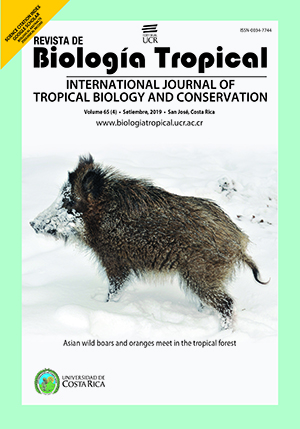Abstract
Socio-ecological and conservation aspects of a small community of bottlenose dolphins Tursiops truncatus (Odontoceti: Delphinidae) in Santa Elena, Ecuador. A resident community of bottlenose dolphins (Tursiops truncatus) has been studied irregularly between 2005 and 2018 around the tip of the Santa Elena Peninsula, Ecuador (2°11'S, 81°0.7'W). Opportunistic sightings and systematic surveys from the beach and at sea from a boat were carried out along 40 km of coast, accounting for 917.2 km of tracking by car from land and 707.4 km of boat tracking by sea. Average group size was 5.31 dolphins/group (SD= 1.97, range 1-10), with no significant changes throughout the study period. From land, however, the group size was underestimated 32% on the average. This small dolphin community currently has only nine individuals, including six adults, one immature and two calves. The relative abundance ranged between 0.03 dolphins/km in the northwestern part and 0.32 dolphins/km in the south, where dolphins concentrate their activities, possibly because human activities are less intense. Dolphins were generally distributed in the first 200 m from the shore, reaching up to 1,200 in the northern shallower part and where port and tourist activities concentrate. The dolphins’ speed was significantly higher when they were followed from a boat at close range (5.87 km/h) than when they were monitored from the beach (2.9 km/h) (P < 0.01), which suggests that boat tracking had an effect on dolphin´s movements. Pairwise cluster analysis showed that animals from this community show high rates of association among each other (average 0.67, range 0.01-1.0), indicating this is highly cohesive population unit. Dolphins also showed high level of residence (average occurrence index = 0.62). During the study, two main threats were identified, a gillnet fishery in the southwestern part and an intense fishing boat traffic in the northwestern. This coastal bottlenose dolphin community is the smallest of this species ever reported in the Gulf of Guayaquil, probably is a remnant of a larger population that would be in process of extinction. Most of the study area is currently part of a coastal-marine protected area created in 2008, which offers an opportunity for the recovery and conservation of this dolphin community. Given the fragility of this population unit, we recommend to environment authorities addressing potential threats by eliminating gillnets, implementing an exclusion zone for fishing gear and fishing boat traffic of 1 km width from the shore and limit the speed of any type of vessel to 10 knots within the reserve.
##plugins.facebook.comentarios##

This work is licensed under a Creative Commons Attribution 4.0 International License.
Copyright (c) 2019 Fernando Félix, Melanie Zavala, Ruby Centeno


